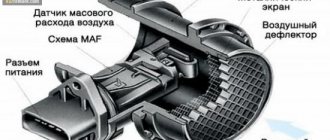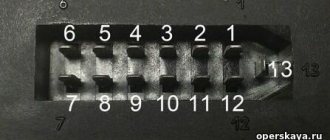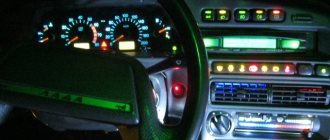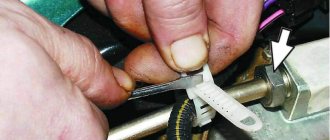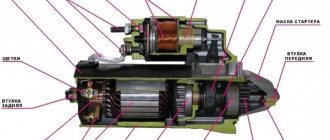For safe vehicle movement at night, lighting devices such as headlights, side lights and fog lights are used. The VAZ 2114 has excellent light optics that help the car move safely at any time of the day. But what to do when reversing in the dark, because the headlights on a car are only at the front, so car engineers came up with special rear running lights that turn on when reversing.
Quite often it happens that the rear running lights on a VAZ 2114 stop working, and this leads to difficulty reversing at night.
In this article we will talk about solving the problem of why the rear running light stops working on a VAZ 2114 car.
Faulty reversing lights on VAZ 2114
Reversing lights for VAZ 2114
What are reverse lights? These are white road lights that turn on in reverse gear, guaranteeing safety while driving. If the reverse lights are not on, then the possibility of the driver getting into an emergency increases; it is very difficult to park in the dark when the road is not visible, and passengers will not be able to predict the actions of vehicles, which can lead to unpleasant consequences.
The frog signal device is a necessary device. As they say “in the language of a motorist”: everything that is in the car must function properly, the safety of vehicle traffic depends on it!
So, at the slightest breakdown or short circuit of the reverse light, you need to immediately begin repairing it. This can be done both at service stations and at home, quickly and very simply. And this theoretical basis will be a great help!
CAUSES OF REVERSE DIRECTION FAILURE
What could cause the lack of illumination to the rear headlights?
- The light bulb has burned out and you simply need to replace it by checking the contacts.
Reverse light on VAZ 2114
- The fuse has failed, which can disrupt the functionality of the complete circuit of contacts.
- Lack of mass on the board, which is located under the lamp.
Rear light board for VAZ 2114
- Plaque and oxidation have formed on the contacts.
- If the wiring is broken, you can check it visually and also make a call.
- The contact on the headlight film burned out.
- Malfunction of the gearbox mechanism.
Reverse sensor for VAZ 2114
- The reverse frog of a VAZ 2114 is broken.
This is why the reverse lights on the VAZ 2114 do not light up!
There can be many reasons, which means that every driver should know how to properly eliminate such malfunctions.
Place of the switch in the light switching circuit
On cars with manual transmission, voltage to the lamps when reversing is supplied through a limit switch (the so-called frog), which is screwed directly into the gearbox housing. When reverse gear is engaged, the switch button is pressed inside the gearbox. The contacts inside the “frog” bridge, and current begins to flow to the lamps.
On the circuit diagram for turning on the reversing lights, we can see that on the VAZ 1118 Kalina, the current from the battery through the ignition switch (No. 2) is supplied to fuse F1. Passing through the fuse that protects the switching circuit, “+” goes to the limit switch (No. 10). The contacts are in a normally open state and close only when reverse gear is engaged. Thus, current begins to flow to the light bulbs. The second contact of the lamps is connected to the “–” battery through the common ground contact of the lamps.
On cars with automatic transmission, the role of the limit switch lies with the selector position sensor. Information about changing the location of the gearshift knob is transmitted to the engine ECU, the light control unit.
How to check the "frog"
- Remove the headlight switch chip.
- Turn on the ignition.
- Using a small piece of wire, connect the contacts of the reverse gear sensor connector to each other.
If the reverse lights are on, then the problem is in the “frog”. Some drivers disassemble the switches, clean the contacts, after which the device continues to work properly. It is up to you to judge the appropriateness of such measures. But keep in mind that on many cars (including VAZ models) the limit switch is located below the oil level in the gearbox. We recommend simply replacing the power sensor. To minimize oil loss, jack up the car on the side where the end switch is installed.
On some cars, the reversing lights do not light up due to incomplete activation of the limit switch. The problem can be solved by installing a thinner washer under the “frog”. To make sure that the switch is working, check with a multimeter in ohmmeter mode whether the contacts close when you press the button.
Checking the circuit
The essence of diagnosing the reason why the reverse lights do not work comes down to identifying the section of the circuit where the voltage is lost. To do this, you can use a regular control light. Continuity testing is done with an ohmmeter, so you need to know how to use a multimeter.
You can start checking directly from the limit switch connector. Turn on the ignition. Connect one contact of the control light to an unpainted metal part in contact with the body, and the second to the “+” connector.
- If power comes in, check the reverse sensor.
- If after installing the “jumper” in the connector the lights do not light up, then the problem is in the section of the wire circuit going from the connector to the lights. Ring the wire to the point where it divides into light bulbs on the left and right sides. Most likely, the reason is the break.
REMOVAL OF THE BACK BOARD
First you need to remove the rear lights on the VAZ 2114, and for this you will need:
- Open rear trunk
- Remove unnecessary things
- Remove decorative trim
- Unscrew the plastic casing
- Take out the back panel
Now you have access to the socket and lamp of the rear license plate lamp, which also needs to be removed. The frog mounting pins are removed and the flashlight is already in your hands. The main thing is not to confuse it with the speed sensor, which is also located on the gearbox.
HOW TO CHECK THE OPERATION OF THE FROG?
The contacts from the sensor are removed and clamped together, after which the ignition is turned on. If there is light, then you need to replace the sensor. And if not, then the problem is in the circuit, but the frog is fine.
When the reverse lamp does not light up, it is often necessary to replace the old sensor with a new one.
What should be done:
- place the car on the overpass;
- install the handbrake;
- remove protection;
- remove the contacts of the old sensor;
- place the container and remove the frog;
- Unscrew the faulty device and replace it with a new one.
Then let it sit for a while and check the oil in the gearbox. Fill it up to the required level and put the entire structure back together.
Attention, the price of a new sensor is within 250 rubles.
The next option is if the reverse light does not light up on a VAZ 2114, then the problem is in the light bulb. To replace it, you need to disconnect the wiring block, remove the plastic contact panel from the flashlight, while squeezing the side fixing elements.
We rotate the light bulb counterclockwise and, pressing slightly on the socket, remove it. Now we install a new one, check the contacts and put the entire unit back together.
We visually assess the condition of the wiring; if necessary, we strip the wires, check for breaks using the ringing method, and check the contacts on the headlight film.
A blown fuse is a common cause, which means you need to know exactly where they are located and how they change.
The products are located in the fuse box, which can be found under the steering wheel on the left side. It can be easily removed with just one touch of your hand. There is no need to unscrew anything.
When the reverse light does not light, you need to check the condition of the fuses. How to do this? You can visually look at the fuses and determine the breakdown - the integrity of the middle part.
But the burnt jumper is not always so clearly visible, so you need to turn on the dimensions and, without removing the fuses, check the voltage; if one end is on and the other is not, the device is faulty.
Attention: when such a breakdown often occurs, you need to check the entire electrical wiring system, which causes such malfunctions in the car.
To replace the product, you don’t need tools, just take tweezers, remove the old unit and install a working one.
MAIN CONCLUSIONS AND RECOMMENDATIONS OF PROFESSIONALS
You can find out where the VAZ 2114 reverse sensor is located very simply by looking up at the gearbox, and if the driver cannot get under the car, then the hood opens and thus the condition of the frog is checked.
To completely verify that the brake gearbox is damaged, you need to turn the wheels to the left and look at the gearbox from the driver’s side. There is a protection with contacts inside on the side, remove it, close the contacts on the DZH and turn on the ignition. When everything is in order, a white light appears.
If not, then use a tester to measure the voltage on ground and on the orange wire that comes from the frog. If voltage is present, then we check the flashlight board itself and clean the contacts.
There is also a chance that the contact between the frog and the fuse block has “frozen”; you need to find it and check its condition.
Attention: when everything is normal, but the lights do not light, the reason may be the contact of the lamp, so even when screwing in a new one, you must check its functionality. As the people say, it’s no joke, because a breakdown can be the easiest, but it can lead to a lot of troubles.
This is why the reverse light on the VAZ 2114 does not light up, as you can see, there can be many reasons, and for the motorist it is important to carefully check the integrity of all frog mechanisms, identify the malfunction and repair the functionality of the lighting.
Have a nice journey, good fellow travelers and a smooth road!
Search principle
To find a fault in any vehicle on-board network system, you should use the method of sequential elimination of elements. The point is to consistently check electrical appliances and sections of the circuit, excluding elements from the list of reasons that could cause a breakdown. To do this, you need to clearly understand the design and operating principle of the system. When troubleshooting, you need to move from the components that require the least effort to check, to the most difficult to diagnose elements.
Electrical diagram
We immediately emphasize that the pinout of connectors and color markings of wires may differ not only between different models of the same automaker, but also among one model of different years of manufacture. Before you start searching for the cause of the breakdown, you need to find an electrical diagram specifically for your car model.
We will consider the principle of operation of brake lights and the troubleshooting algorithm using the example of the VAZ 2101-2102 circuit. The photo shows the general diagram of the vehicle's lighting and light signaling. We need to isolate the components involved in the operation of brake lights.
- 6 – mounting fuse block;
- 13 – brake light switch. It is a non-locking button (returns to its original position after removing the force). Located directly next to the brake pedal. When the brake pedal is released, the contacts of the limit switch are open, no current passes through it. Accordingly, when pressed, the contacts close, allowing flow through the lamps;
- 19 – lamps that light up when you press the brake pedal.
We do not have a diagram of the mounting block, but we know in advance that the brake lights only work when the ignition is on. There is a wire from the mounting block to the brake light limit switch, on which there is a constant + after the ignition is turned on. As soon as the limit switch contacts close, + goes to the brake light bulbs, which are connected in parallel. The “ground” of the rear lights is common and consists of a wire screwed to the car body.
In the diagram we presented, the elements are depicted as close as possible to how they look in reality. Don’t be alarmed if you only find a schematic diagram for your car with symbolic images of the elements. Schematic diagram of external lighting for VAZ 2114, 2115:
- 3 – mounting block;
- 8 – lamps for side lights and brake lights;
- 11 – brake light limit switch;
- K4 – relay for monitoring the serviceability of brake light lamps and side lights.
Causes of failure
The main reasons for malfunctioning reverse lights are as follows:
- light bulbs burned out;
- fuses are blown;
- oxidation of contacts in lamp sockets occurred;
- lost contact with the mass;
- the reverse wires have broken;
- the reverse sensor (otherwise called the frog) is broken;
- Damage has occurred on the contact board.
Thus, if the reversing lights of the VAZ 2114 do not light up, then the problem lies in one of the reasons given above. For a more accurate search, you should check all the specified elements one by one, starting with the light bulbs and their sockets and ending with the contact board and the sensor itself. And if the simplest faults can be eliminated almost instantly - by replacing light bulbs or wires, then replacing the reverse sensor requires a more serious approach.
Checking and replacing the contact panel and DZH
In order to remove the panel you need to do the following:
- Open the trunk.
- Remove all contents from it that may interfere with the repair.
- Remove decorative trim.
- Remove the plastic casing.
- Remove the back panel.
- Disconnect the studs securing the reverse sensor.
To remove the sensor itself and replace it, you need to proceed in this order:
- disconnect the minus from the battery;
- remove the sensor protection;
- disconnect the contacts of the wires suitable for the DZH;
- place an oil container under the sensor;
- Unscrew the sensor using a 22mm wrench;
- remove the old sensor and insert a new one;
- wipe the box from traces of leaked oil;
- perform assembly in the same sequence and in reverse order;
- if too much oil has leaked out, it should be replenished to the required level (the level itself should be checked immediately after replacing the sensor in order to avoid the gearbox operating when the oil level is low).
The entire operation of replacing the old reverse sensor with a new one should be performed very quickly. Otherwise, very large amounts of oil may leak out and cause contamination of the surrounding surface.
You can check the sensor quite simply - you just need to close its contacts and turn on the ignition. If the rear white light comes on, then the sensor is working and the problem lies in the electrical network. If the light does not light up, it means the auxiliary switch is broken and needs to be replaced with a new one (how to do this was described above)
If the frog turns out to be in good condition, then you should check the continuity of all wires suitable for the sensor and headlights, and also check the condition of the contacts of the lamps and sockets (if they are oxidized, you need to clean them or wipe them with WD-40). It is also necessary to check the serviceability of the reversing lamp fuses located in the common fuse block.
If the rear lights fail quite often, and the cause of this is blown wiring or fuses, then you should check all the electrical wiring of the car as soon as possible. After all, some other, serious malfunction of the internal electrical network can lead to such breakdowns.
If, even with a working sensor, light bulbs and wiring, the reverse gear of the VAZ 2114 still does not light up, the reason may lie in a burnt-out contact located on the headlight film. This kind of malfunction is very common on VAZ cars. In order to solve it, you can either modify the contact group on the board yourself, or simply replace the board with a new one.
Repair methods
To repair the reverse signal, you can proceed in two ways. They differ in the way the sensor is accessed.
- Drive the car onto a lift or pit.
- Do the work by climbing under the car.
If you have already encountered a similar problem, then you will probably agree that replacing the DZH is best done using a pit or overpass. This makes access to the sensor as comfortable as possible, plus you minimize the risk of being splashed with oil from the gearbox.
Replacing the DZH is not the cleanest job
Of course, there is another cleanest way - sending the car to a car repair shop. But then you will have to pay not only for the sensor, but also for the services of the specialists. And this is another 2-3 times the cost of the sensor. The choice is yours anyway.
Self-replacement
It’s not difficult to get to and replace a failed DZH on your own. Follow the instructions, do not break the sequence of operations, and then the process will not take you much time and effort.
- Place the car on a pit or overpass. Be sure to apply the handbrake and place the transmission in first gear. This will help prevent your car from accidentally rolling away.
- Remove the protection from the contacts of your sensor, disconnect the contacts.
- Prepare a container into which the oil will be drained when unscrewing the DZH.
- When the container is ready, remove the sensor. In some cases, it may not be unscrewed by hand. In such a situation, use a 22 mm socket.
- Very rarely even the key cannot help, since the sensor becomes stuck to its location. Here you will have to arm yourself with a hammer and chisel and try to remove it as carefully as possible.
- Take out the failed device and insert a new one in its place.
- If oil gets on the gearbox housing, remove it with dry rags. There is no need for extra dirt. Plus, it can lead to a decrease in the efficiency of the device.
- Return all contacts to their places, put the protection back on.
- If a decent amount of lubricating fluid has spilled out of the box, be sure to top it up. Just use fresh ones. By the way, this is one of the reasons to completely change the oil in the gearbox if it has been there for more than the first season.
- The decision to change the oil will simplify the task when removing the sensor. If the liquid is drained in advance, it will not flow in different directions when the sensor is unscrewed. The work will be cleaner, plus you will kill two birds with one stone - replace the sensor and gearbox oil.
Opening the black box or treating reversing lights
I’ve been making frequent recordings in recent days, but it’s empty and thick :-D, but oh well, today we’ll talk about how I struggled with the reverse lights.
About two months ago, when the tree was still standing, I took it to the car wash, washed up all right, drove it home, left the car behind the fence and went home. In the evening I went to drive the car into the garage, I turned on the rear and my tidy went out, the side and the rear too. . . What the f*ck did you think, let’s run to GOOGLE, they say fuse, look, idiot. . I look at the fuse and it’s not a thorn.
Here it is F16 - highlighted in red
I put another one on and turn on the rear one and the same story, well, that means the black box lock (aka fuse block or fuse box) I should have thought of sticking it under the drain. . . on the street there was no desire to fiddle with an oak tree with a block, and the wires were oak, so I took the easier route, threw the chip off the sensor and forgot about it, washed it down, and killed it. . . You can drive like this, of course, but it’s not comme il faut, especially in a parking lot when you’re driving and people don’t even know which way. Today I began to solve this problem, first I found out which contacts of the fuse block the wires from the sensor go to (Base X6, contacts 2 - green and 12 - orange), threw off the CYA, took this block and rang the wires to the sensor with a multimeter for a short circuit (a goat in the people) , the wires are fine, let's continue digging. I took it apart and let’s see what’s wrong where, in principle, all the normal tracks have not oxidized, there’s nothing to short-circuit either, but it’s one thing to just look and another to call and make sure that everything is fine here. To dial the tracks I had to delve a little into the diagram. From the diagram it follows that “+” goes from fuse F16 to the 12th contact of the X6 block and goes to the sensor (orange wire), passing through the sensor it returns to the 2nd contact of the X6 block (green wire) and from it goes to the X9 block Pin 16 (Output for reversing lamps)
I sketched out what goes where
Connection of blocks X6 and X9
You can see from the photos and the diagram that everything is simple here, I called, everything is fine, there is no goat, I started looking further. . . I dismantled the rear lights, maybe there is a goat walking from them and butting, but here too everything is in order, no hints of a goat, the wire from the CY to the lights rang, everything is also in order. . . Then great thoughts began about where and what could be. . . After sitting, thinking about it, weighing all the arguments and evidence, I decided to check the sensor itself, because... The fuse blows only after reverse gear is engaged, everything is in order in the control unit and wiring. I rang the contacts on the ground sensor, everything is fine and I started thinking again. . . then something pulled me to turn on the reverse gear and ring IIIIII BINGO again, one contact in the on state goes to ground!
Here it is, the green wire contact
How are car wash and reverse gear sensor related? There are mudguards in the engine compartment; a jet of pressure simply could not get to the sensor and damage it! I don’t understand shit at all. . . but the fact remains that the sensor needs to be replaced. I changed the sensor, assembled the fuse box, stuck it in place and here is the result
» />
Everything works great
Literally a week before, the dimensions on the left side and the lighting in everything in the cabin disappeared, the fuses were intact, the problem turned out to be in the CY
The solder contact spot between the bottom board and the top board is highlighted.
The soldering was oxidized and the output was only 5 volts instead of 12, 5 minutes of work with a soldering iron, two strokes of nail polish and everything returned to normal)))
To everyone who finished reading this entry, my respect, because not everyone will read this dregs))) Of course, it was possible to write everything in short, but I don’t like writing like “I spat, stuck it, put it on top with tape,” and I wanted to tell the full story of my misadventures!) ) So don’t rush to immediately throw off the fuse block and tear it to pieces, everything may turn out to be much simpler))) Learn from other people’s mistakes)))
Operating principle, design and characteristics of fuses
A protective device of this type consists of a housing, which is usually made of high-strength ceramics or special glass, and a fusible insert made of a conductive metal or alloy.
The body performs several functions:
- a fuse-link is built into it in a special way so that when the rated current of the insert is exceeded, it melts or breaks;
- the working thread is inserted into the chamber to extinguish the electric arc that occurs when the circuit breaks; this chamber is equipped in the housing;
- on the body, in those places and in the form as provided for by the fuse design, there are working contacts through which it must be connected to the general network.
Information about the characteristics of this protective device is printed on the housing. This is the rated current of the fuse link and the rated current of the fuse body at which it breaks.
According to their performance characteristics, these protective elements are divided into:
- fast-acting;
- low voltage;
- designed for medium voltage;
- manufactured for high voltages.
In automotive networks, the first two types are used.
The defining point showing the purpose of a particular protective device with a fuse link is its current characteristics. It is she who speaks about the range in which this element is ready to work.
- To protect electric motors, fuses are installed whose inserts can withstand the rated current and its excess for a sufficiently long time necessary to start the main mechanism and reach its operating range. As a rule, such chargers (protective devices) are marked - g - as devices ready for protection from both overload and short circuit.
- There are protective devices that operate effectively during short circuits and protect all equipment from very high voltage currents. Such chargers are marked - a - for protection only against short circuits.
Fuses for cars have several versions:
- low-current inserts, in networks up to 20 A, made of glass with a thin wire insert, there are ceramic cases, the ends are made of metal;
- fork inserts, most commonly used in vehicles, come in miniature and regular types.
According to GOST, a painting system for fusible chargers has been adopted depending on the rated current of the insert. 2 A - gray, 4 A - pink, 5 A - orange-yellow, 7.5 A - brown, 10 A - red, 15 A - blue, 20 A - yellow, 25 A - white, 30 A - green.
Fuse colors
Why doesn't the reverse light come on?
If your reverse lamp does not light up, then the reason may lie in several problems:
- The reverse light does not light up. We replace the corresponding light bulb. How to replace a light bulb, see Replacing side lights
- Circuit breakers. Fuse f16 simply blew. Look and check, if necessary, replace it. Just in case, check the other fuses and maybe the problem lies there. How to check fuses, see Fuses.
- The contacts have oxidized. Remove the taillight unit and clean the contacts. Clean the contacts on the reverse sensor.
- There is no ground on the board. We put the mass or just tighten it. The mass is located under the lantern.
- Broken reverse sensor wire. We check and call.
- The reverse sensor is broken. First you need to check the reverse sensor. To do this, we put the car on an overpass, disconnect both wires from the reverse sensor (frog) and connect them together. Then turn on reverse gear and ignition. If the reverse light does not light up on your 2109, then you need to change the reverse sensor.
- The contact on the headlight film has burned out. This is a disease of all samars, and it can be treated by replacing the stock board with a modified one, or making the contact group yourself without using headlights. Here are some examples of improvements.
